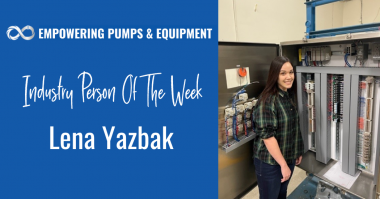Author: Sam Kelton
To put it simply, pumps work based on the principle of pressure difference: Fluids flow from regions of higher pressure to regions of lower pressure, and pumps facilitate fluid transfer by creating a pressure difference, or pressure head.
A low pressure is created at the pump inlet, allowing fluid to travel through the pump. The low pressure created at suction and atmospheric pressure determines the height to which a fluid can be transported, and the height to which a pump can lift a fluid will play a key role in determining net positive suction head (NPSH).
NPSH is defined based on two distinct aspects: the available NPSH (NPSHA) and required NPSH (NPSHR). NPSHR is set by the pump manufacturer, while NPSHA — the actual/absolute pressure available at the pump suction inlet — must be calculated. In order for the system to operate effectively, the NPSHA must be greater than the NPSHR.
Understanding NPSH
To better understand how suction head affects system performance, consider the calculation required to figure out NPSHA.
If a liquid at a certain pressure is to be pumped, then the suction head must be at least equal to the sum of atmospheric pressure plus the height difference between the liquid surface and the centerline of the pump plus pressure head contributed by fluid velocity.
In real-life systems, however, the contribution of velocity head is usually negligible.
This pressure head is sufficient for pump operations in which the system has no losses. However, in real-life scenarios, frictional losses must also be subtracted from this head. It’s essential that the working liquid pressure remains above the fluid vapor pressure in order to avoid any type of phase change.
Therefore, NPSHA is the sum of atmospheric pressure and height separation between the liquid storage tank and pump centerline, minus the vapor pressure for the operating temperature and any losses due to friction. If this NPSHAis greater than the required NPSH (NPSHR) of the pump, the system will operate smoothly.
Dealing With Pump Cavitation
In some cases, due to improper system design, the NPSHA will not be greater than the NPSHR. This can cause serious pump problems in the long run. When the absolute pressure head is not high enough, the pressure of the operating liquid may fall below the vapor pressure, forming vapor bubbles within the system.
These bubbles typically form near the end of the plunger, on the seating surface and valve member or disc in the suction valve assembly in areas of low pressure. The bubbles then move to regions of higher pressure and implode against equipment surfaces. These imploding bubbles then generate shockwaves, causing a number of problems.
The most common problem — and a telltale sign of cavitation — is a banging sound and vibration which can lead to powerend failure. Cavitation can also cause mechanical damage and pitting, ultimately leading to mechanical failure of components.
And since cavitation also prevents the pump from operating at its full capacity (as vapor takes up more volume than liquid), the entire process becomes less energy-efficient. To avoid these and other related issues, great care must be taken to ensure the NPSHA is greater than the NPSHR.
Triangle Pump Components, Inc. manufactures efficient, long-lasting, and dependable pump components. With almost 100 years of experience and expertise, we help customers solve any reciprocating pump problem. We invite you to discuss your specific needs with an expert and request a quote today.





Comments